理论知识部分
1.数据结构:一般将数据结构分为两大类:线性数据结构和非线性数据结构。
线性数据结构:线性表、栈、队列、串、数组和文件。
非线性数据结构:树和图。
2.JAVA的集合框架:
JAVA的集合框架实现对各种数据结构的封装,以降低对数据管理与处理的难度。所谓框架就是一个类库的集合,框架中包含很多 超类,编程者创建这些超类的子类可较方便的设 计设计程序所需的类。
集合(Collection或称为容器)是一种包含多个元素 并提供对所包含元素操作方法的类,其包含的元 素可以由同一类型的对象组成,也可以由不同类 型的对象组成。
3.集合类:
集合类的作用:Java的集合类提供了一些基本数据结构的支持。例如Vector、Hashtable、Stack等。
集合类的使用:Java的集合类包含在java.util包中。
集合类的特点:只容纳对象;
集合类容纳的对象都是Object类的实例,一旦 把一个对象置入集合类中,它的类信息将丢失 ,这样设计的目的是为了集合类的通用性。
4.Vector类:
Vector类类似长度可变的数组。
Vector中只能存放对象。
Vector的元素通过下标进行访问。
Vector类关键属性:capacity表示集合多能容纳的元素个数。
capacityIncrement表示每次增加多少容量。
size表示集合当前元素个数。
5.Stack类:
Stack类是Vector的子类。
Stack类描述堆栈数据结构,即LIFO。
6.Hashtable类:
Hashtable通过键来查找元素。
Hashtable用散列码(hashcode)来确定键。所 有对象都有一个散列码,可以通过Object类的 hashCode()方法获得。
7.集合框架中的基本接口:
Collection:集合层次中的根接口,JDK未提供这个 接口的直接实现类。
Set:不能包含重复的元素。对象可能不是按存放的 次序存放,也就是说不能像数组一样按索引的方式进 行访问,SortedSet是一个按照升序排列元素的Set。
List:是一个有序的集合,可以包含重复的元素。提 供了按索引访问的方式。
Map:包含了key-value对。Map不能包含重复的key 。
SortedMap是一个按照升序排列key的Map。
实验部分:
实验1:
测试程序1:
示例程序1
import java.util.Vector;//自动增长的对象数组
class Cat {
private int catNumber;
Cat(int i) {
catNumber = i;
}
void print() {
System.out.println("Cat #" + catNumber);
}
}
class Dog {
private int dogNumber;
Dog(int i) {
dogNumber = i;
}
void print() {
System.out.println("Dog #" + dogNumber);
}
}
public class CatsAndDogs {
public static void main(String[] args) {
Vector cats = new Vector();
for (int i = 0; i < 7; i++)
cats.addElement(new Cat(i));
cats.addElement(new Dog(7));
for (int i = 0; i < cats.size(); i++)
((Cat) cats.elementAt(i)).print();//强制类型转化
}
}

出现错误,dog类不能转换成cat类,修改程序:
import java.util.Vector;
class Cat {
private int catNumber;
Cat(int i) {
catNumber = i;
}
void print() {
System.out.println("Cat #" + catNumber);
}
}
class Dog {
private int dogNumber;
Dog(int i) {
dogNumber = i;
}
void print() {
System.out.println("Dog #" + dogNumber);
}
}
public class CatsAndDogs {
public static void main(String[] args) {
Vector cats = new Vector();
for (int i = 0; i < 7; i++)
cats.addElement(new Cat(i));
cats.addElement(new Dog(7));
for (int i = 0; i < cats.size(); i++) {
if (cats.elementAt(i) instanceof Cat)//加入判断语句,判断是否能进行强制类型转换
((Cat) cats.elementAt(i)).print();//如果能进行强制类型转换,输出为Cat
else {
((Dog) cats.elementAt(i)).print();//不能则输出dog
}
}
}
}
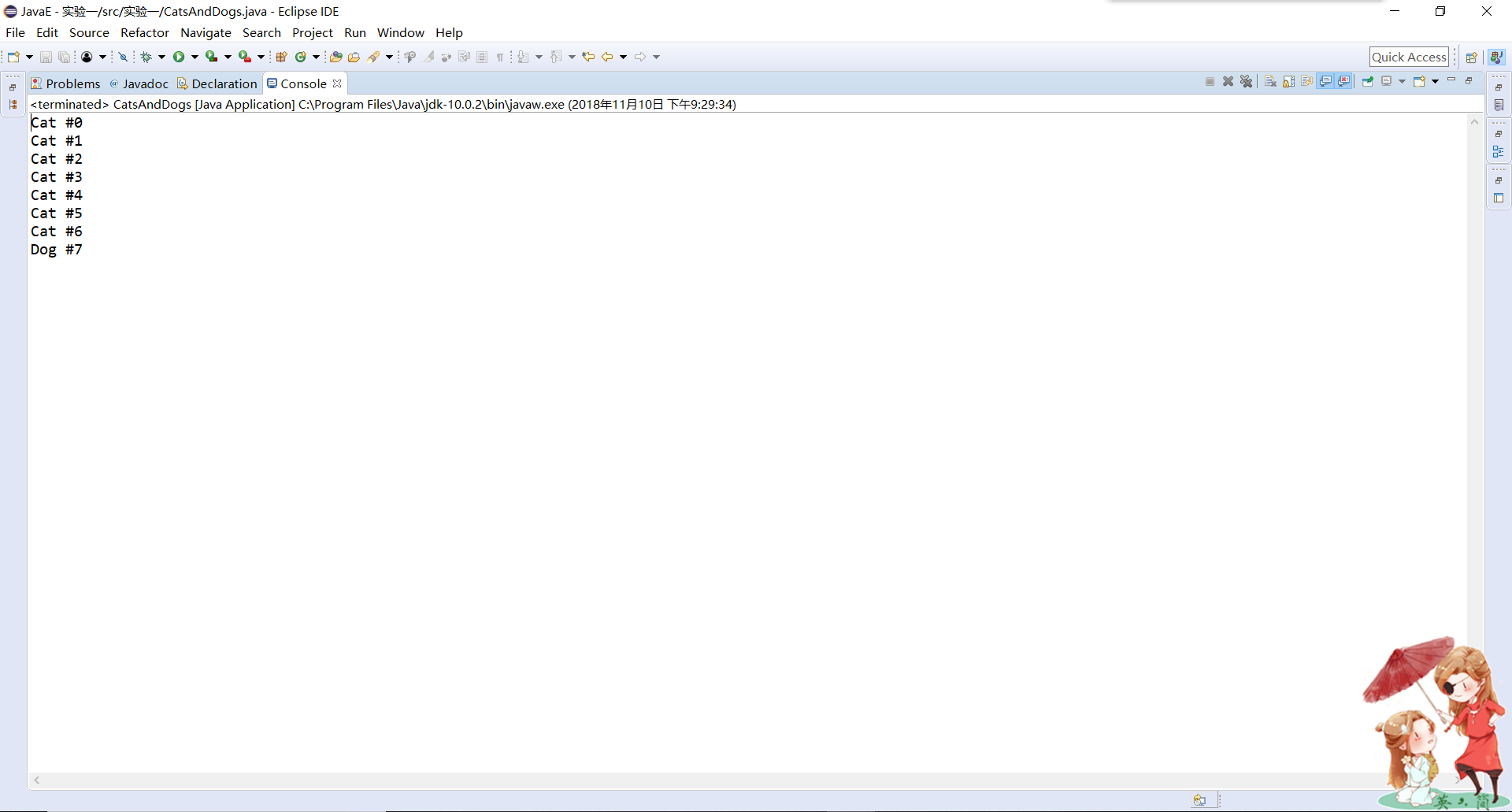
示例程序2:
import java.util.*;
public class Stacks {
static String[] months = { "1", "2", "3", "4" };
public static void main(String[] args) {
Stack stk = new Stack();
for (int i = 0; i < months.length; i++)
stk.push(months[i]);//元素进栈
System.out.println(stk);
System.out.println("element 2=" + stk.elementAt(2));
while (!stk.empty())
System.out.println(stk.pop());//元素出栈
}
}
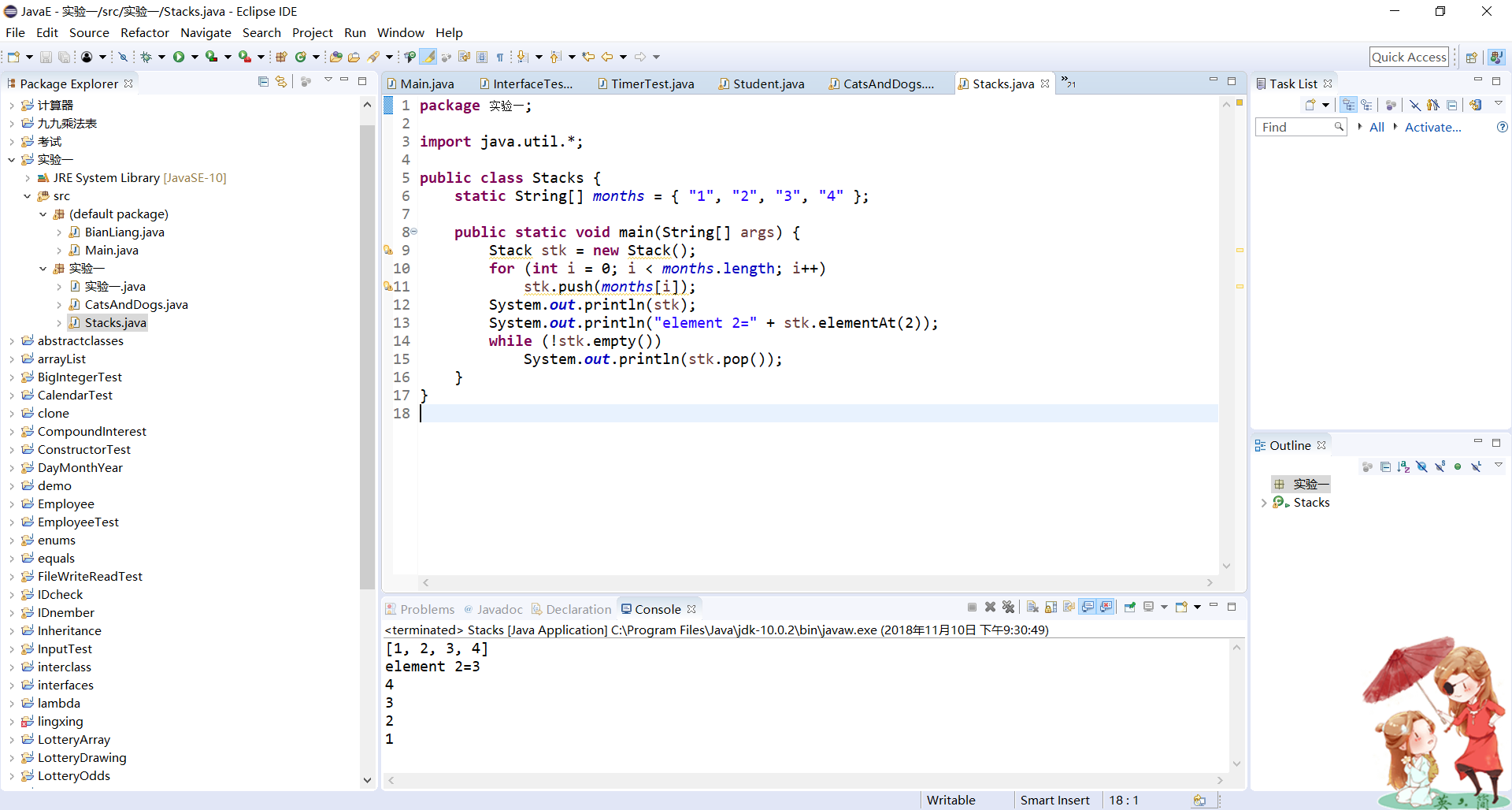
示例程序3:
import java.util.*;
class Counter {
int i = 1;
public String toString() {//把其他类型的数据转为字符串类型的数据
return Integer.toString(i);
}
}
public class Statistics {
public static void main(String[] args) {
Hashtable ht = new Hashtable();
for (int i = 0; i < 10000; i++) {
Integer r = new Integer((int) (Math.random() * 20));//生成0到19的20个整型随机数
if (ht.containsKey(r))//判断r是否是哈希表中元素的键值
((Counter) ht.get(r)).i++;
else
ht.put(r, new Counter());
}
System.out.println(ht);
}
}
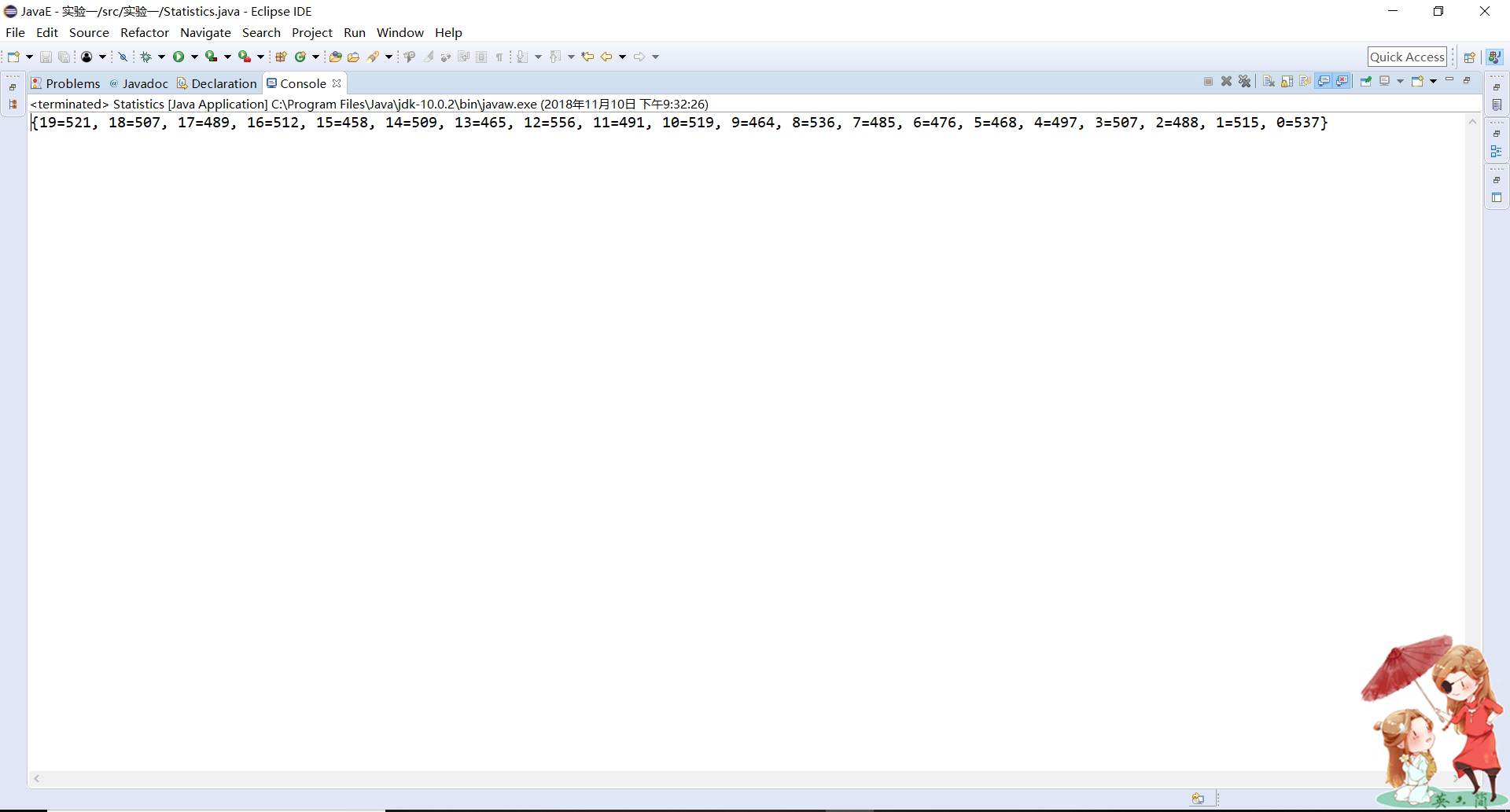
测试程序2:
import java.util.*;
public class ArrayListDemo {
public static void main(String[] argv) {
ArrayList al = new ArrayList();
// //在ArrayList中添加多个元素
al.add(new Integer(11));
al.add(new Integer(12));
al.add(new Integer(13));
al.add(new String("hello"));
// 用循环语句打印
System.out.println("Retrieving by index:");
for (int i = 0; i < al.size(); i++) {
System.out.println("Element " + i + " = " + al.get(i));
}
}
}
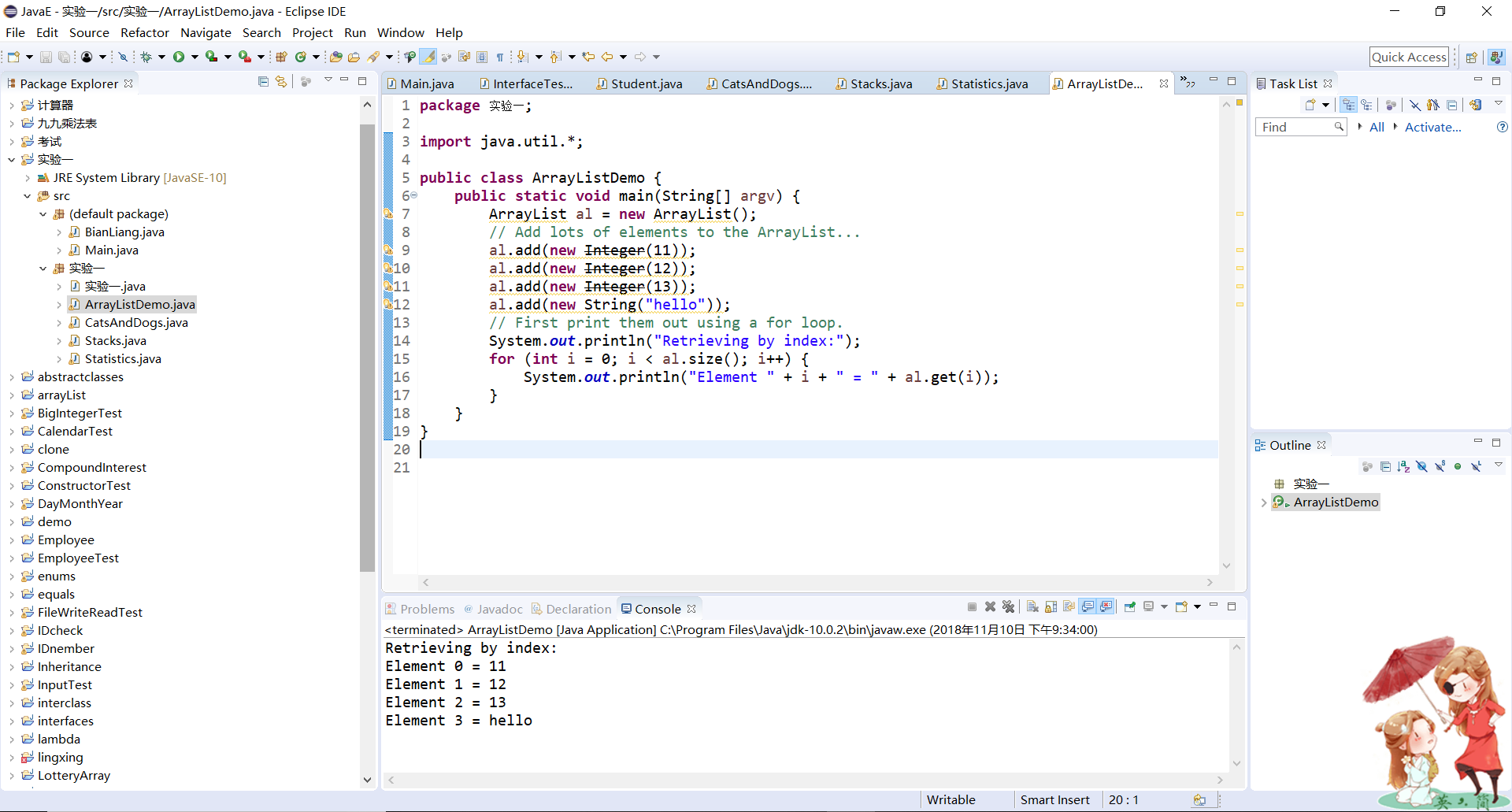
import java.util.*;
public class LinkedListDemo {
public static void main(String[] argv) {
LinkedList l = new LinkedList();
l.add(new Object());//迭代对象生成器
l.add("Hello");
l.add("zhangsan");
ListIterator li = l.listIterator(0);//通过迭代器生成对象产生方法hasNext返回
while (li.hasNext())
System.out.println(li.next());
if (l.indexOf("Hello") < 0) //判断元素是否在集合当中,如果是,返回一个大于0的值,如果不是,返回负值
System.err.println("Lookup does not work");
else
System.err.println("Lookup works");
}
}
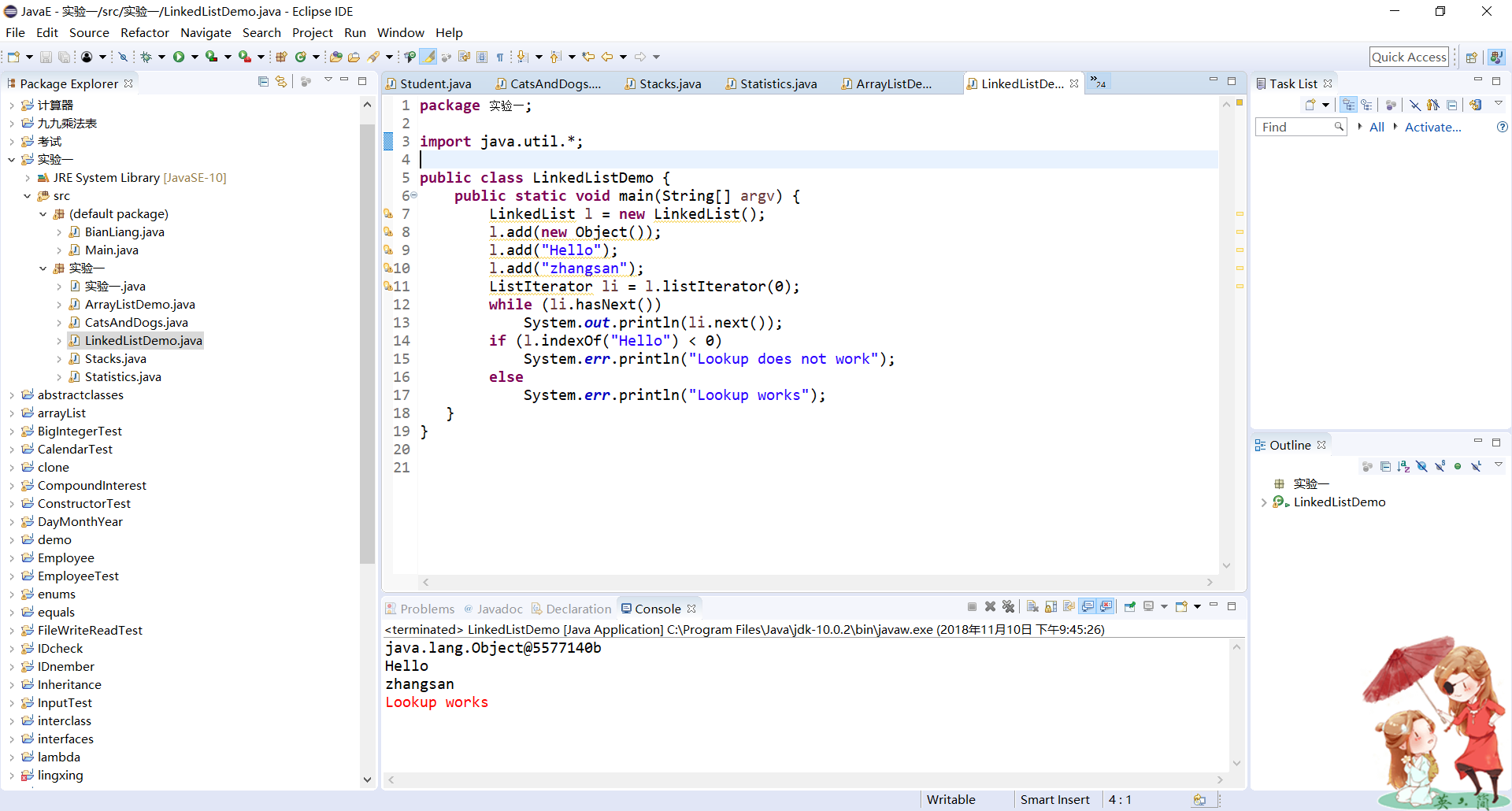
package linkedList;
import java.util.*;
/**
* This program demonstrates operations on linked lists.
* @version 1.11 2012-01-26
* @author Cay Horstmann
*/
public class LinkedListTest
{
public static void main(String[] args)
{
List<String> a = new LinkedList<>();//泛型创建a链表
a.add("Amy");
a.add("Carl");
a.add("Erica");
List<String> b = new LinkedList<>();//泛型创建b链表
b.add("Bob");
b.add("Doug");
b.add("Frances");
b.add("Gloria");
// //合并a和b中的单词
ListIterator<String> aIter = a.listIterator();
Iterator<String> bIter = b.iterator();
while (bIter.hasNext())
{
if (aIter.hasNext()) aIter.next();
aIter.add(bIter.next());
}
System.out.println(a);
// //从第二个链表中每隔一个元素删除一个元素
bIter = b.iterator();
while (bIter.hasNext())
{
bIter.next(); // 跳到第一个元素
if (bIter.hasNext())
{
bIter.next(); // 跳到下一个元素
bIter.remove(); // 删除该元素
}
}
System.out.println(b);
// 批量操作: 删除从b到a的所有单词
a.removeAll(b);
System.out.println(a);
}
}
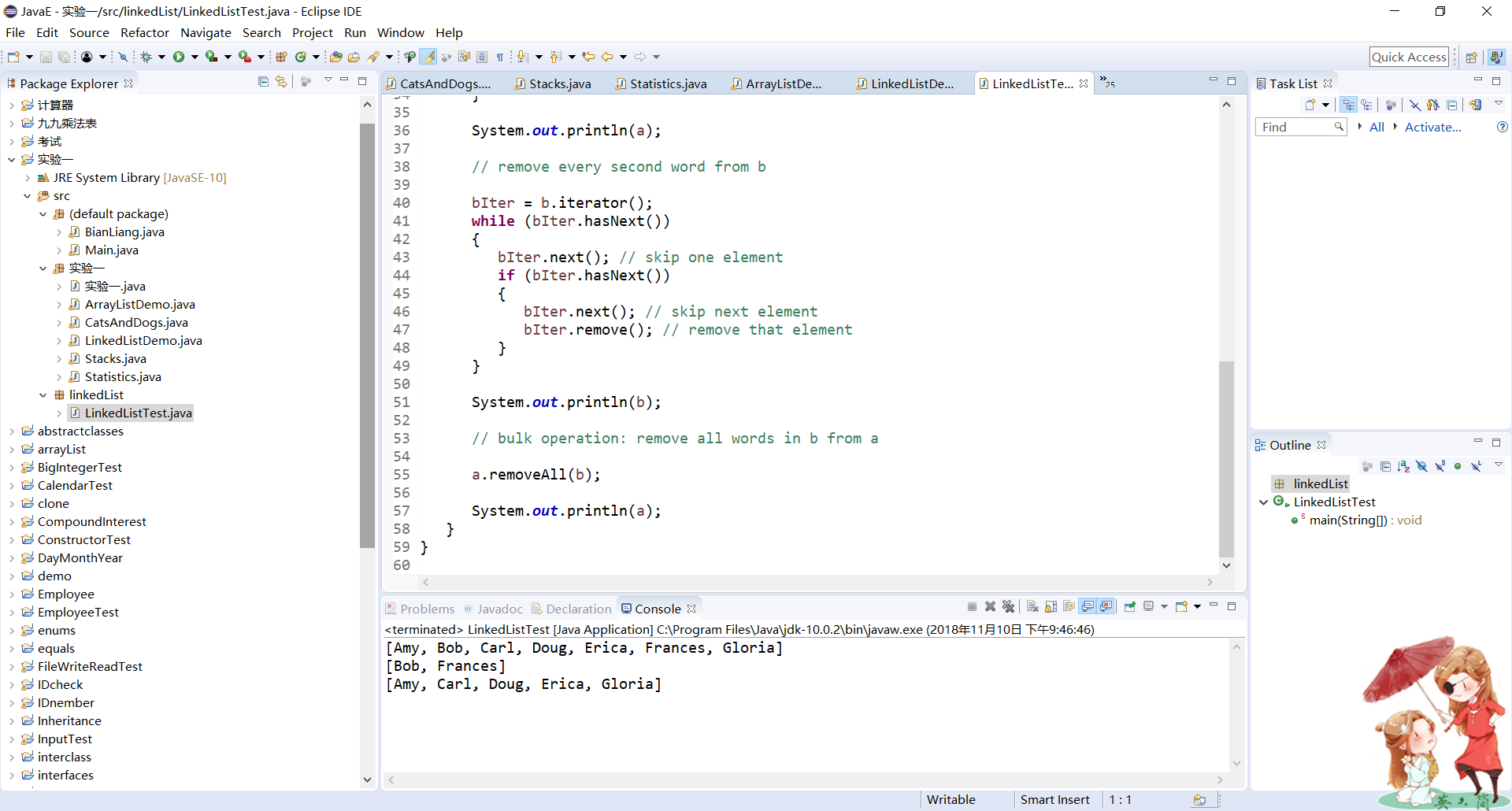
测试程序3:
import java.util.*;
public class SetDemo {
public static void main(String[] argv) {
HashSet h = new HashSet(); //也可以 Set h=new HashSet()
h.add("One");
h.add("Two");
h.add("One"); // DUPLICATE
h.add("Three");
Iterator it = h.iterator();
while (it.hasNext()) {
System.out.println(it.next());
}
}
}
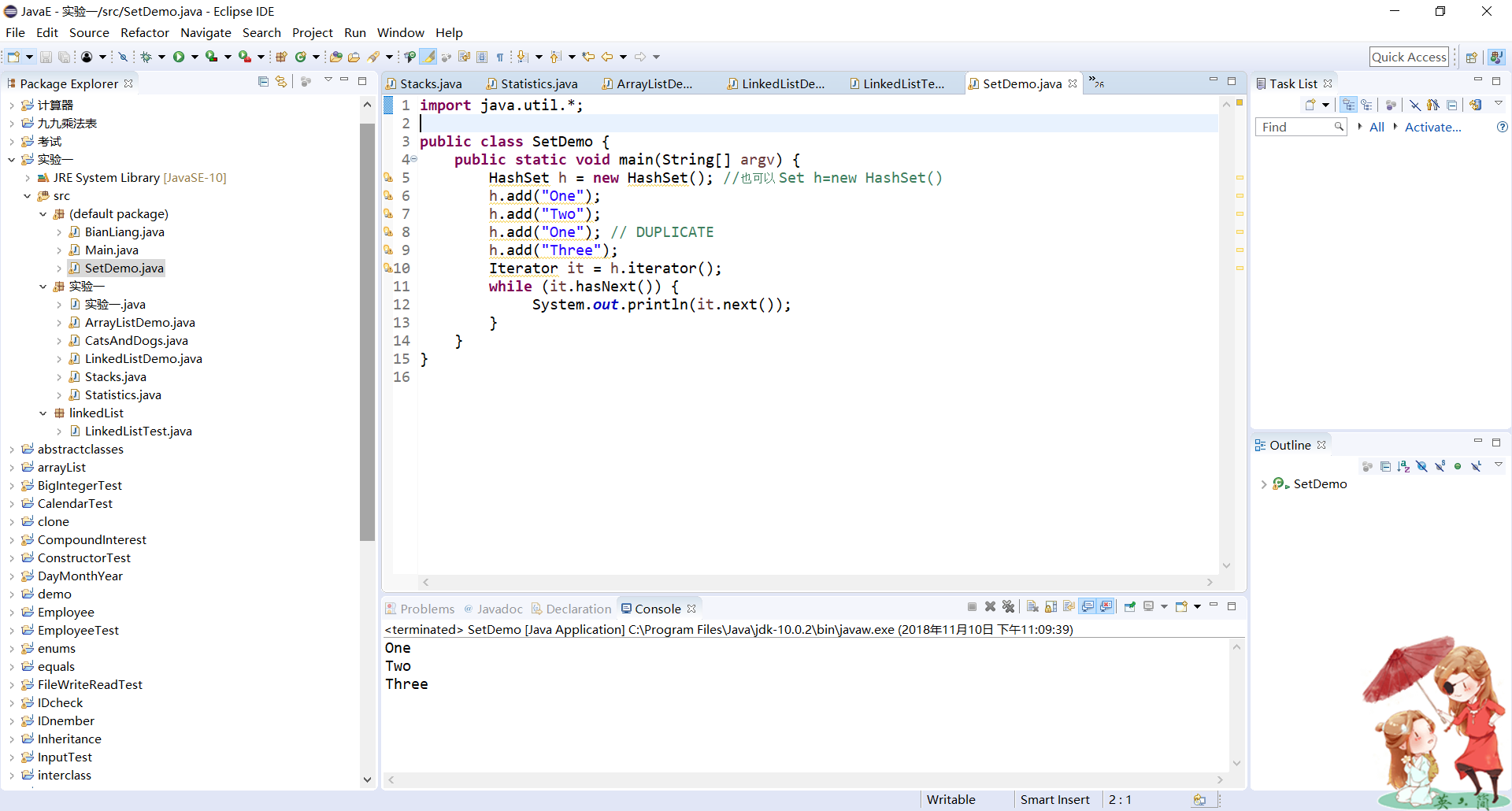
package set;
import java.util.*;
/**
* This program uses a set to print all unique words in System.in.
* @version 1.12 2015-06-21
* @author Cay Horstmann
*/
public class SetTest
{
public static void main(String[] args)
{
Set<String> words = new HashSet<>(); // HashSet 实现 Set
long totalTime = 0;
try (Scanner in = new Scanner(System.in))
{
while (in.hasNext())
{
String word = in.next();
long callTime = System.currentTimeMillis();
words.add(word);
callTime = System.currentTimeMillis() - callTime;
totalTime += callTime;
}
}
Iterator<String> iter = words.iterator();//元素排序
for (int i = 1; i <= 20 && iter.hasNext(); i++)
System.out.println(iter.next());
System.out.println(". . .");
System.out.println(words.size() + " distinct words. " + totalTime + " milliseconds.");
}
}
TreeSetTest.java
package treeSet;
import java.util.*;
/**
* This program sorts a set of item by comparing their descriptions.
* @version 1.12 2015-06-21
* @author Cay Horstmann
*/
public class TreeSetTest
{
public static void main(String[] args)
{
SortedSet<Item> parts = new TreeSet<>();
parts.add(new Item("Toaster", 1234));
parts.add(new Item("Widget", 4562));
parts.add(new Item("Modem", 9912));
System.out.println(parts);
NavigableSet<Item> sortByDescription = new TreeSet<>(
Comparator.comparing(Item::getDescription));//自定义类对象存入TreeSet排序
sortByDescription.addAll(parts);
System.out.println(sortByDescription);
}
}
Item.java
package treeSet;
import java.util.*;
/**
* An item with a description and a part number.
*/
public class Item implements Comparable<Item>
{
private String description;
private int partNumber;
/**
* Constructs an item.
*
* @param aDescription
* the item's description
* @param aPartNumber
* the item's part number
*/
public Item(String aDescription, int aPartNumber)
{
description = aDescription;
partNumber = aPartNumber;
}
/**
* Gets the description of this item.
*
* @return the description
*/
public String getDescription()
{
return description;
}
public String toString()
{
return "[description=" + description + ", partNumber=" + partNumber + "]";
}
public boolean equals(Object otherObject)
{
if (this == otherObject) return true;
if (otherObject == null) return false;
if (getClass() != otherObject.getClass()) return false;
Item other = (Item) otherObject;
return Objects.equals(description, other.description) && partNumber == other.partNumber;
}
public int hashCode()
{
return Objects.hash(description, partNumber);
}
public int compareTo(Item other)
{
int diff = Integer.compare(partNumber, other.partNumber);
return diff != 0 ? diff : description.compareTo(other.description);
}
}
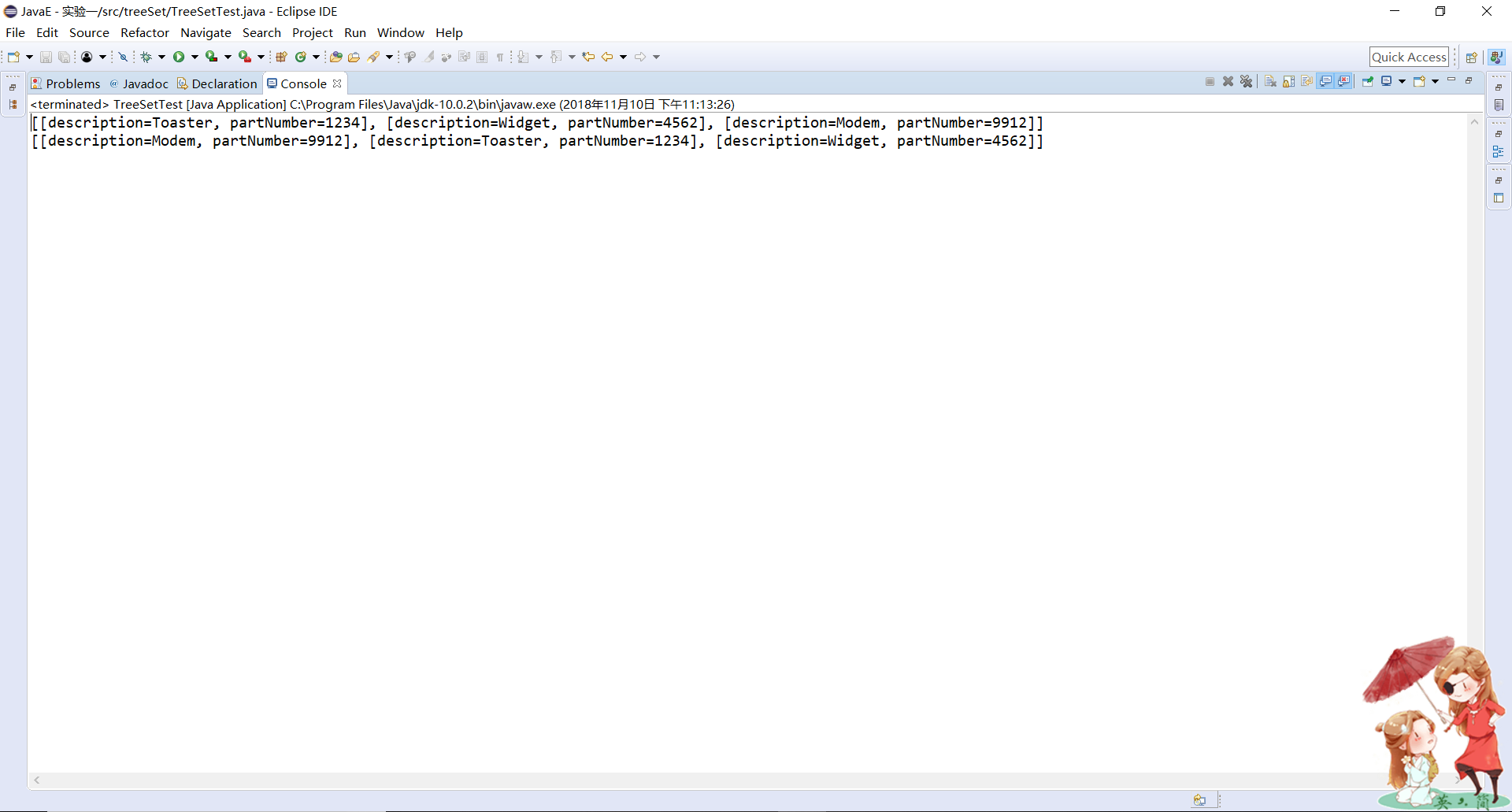
测试程序4:
import java.util.*;
public class HashMapDemo {
public static void main(String[] argv) {
HashMap h = new HashMap();
// The hash maps from company name to address.
h.put("Adobe", "Mountain View, CA");
h.put("IBM", "White Plains, NY");
h.put("Sun", "Mountain View, CA");
String queryString = "Adobe";
String resultString = (String)h.get(queryString);
System.out.println("They are located in: " + resultString);
}
}
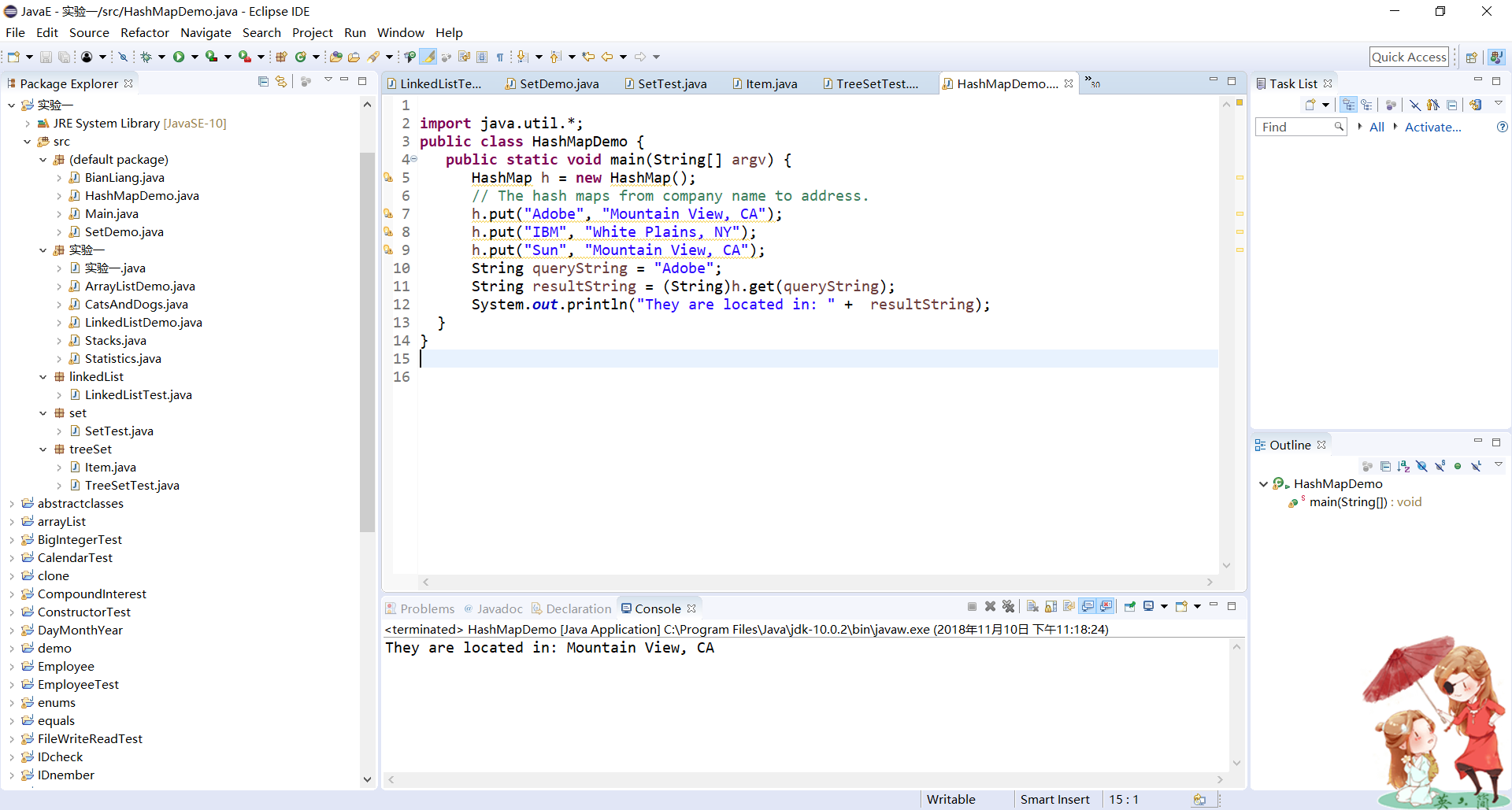
MapTest.java
package map;
import java.util.*;
/**
* This program demonstrates the use of a map with key type String and value type Employee.
* @version 1.12 2015-06-21
* @author Cay Horstmann
*/
public class MapTest
{
public static void main(String[] args)
{
Map<String, Employee> staff = new HashMap<>();
staff.put("144-25-5464", new Employee("Amy Lee"));
staff.put("567-24-2546", new Employee("Harry Hacker"));
staff.put("157-62-7935", new Employee("Gary Cooper"));
staff.put("456-62-5527", new Employee("Francesca Cruz"));
// 打印所有条目
System.out.println(staff);
// 删除一个条目
staff.remove("567-24-2546");
// 替换一个条目
staff.put("456-62-5527", new Employee("Francesca Miller"));
// 查找一个值
System.out.println(staff.get("157-62-7935"));
// 表里所有条目
staff.forEach((k, v) ->
System.out.println("key=" + k + ", value=" + v));
}
}
Employee.java
package map;
/**
* A minimalist employee class for testing purposes.
*/
public class Employee
{
private String name;
private double salary;
/**
* Constructs an employee with $0 salary.
* @param n the employee name
*/
public Employee(String name)
{
this.name = name;
salary = 0;
}
public String toString()
{
return "[name=" + name + ", salary=" + salary + "]";
}
}
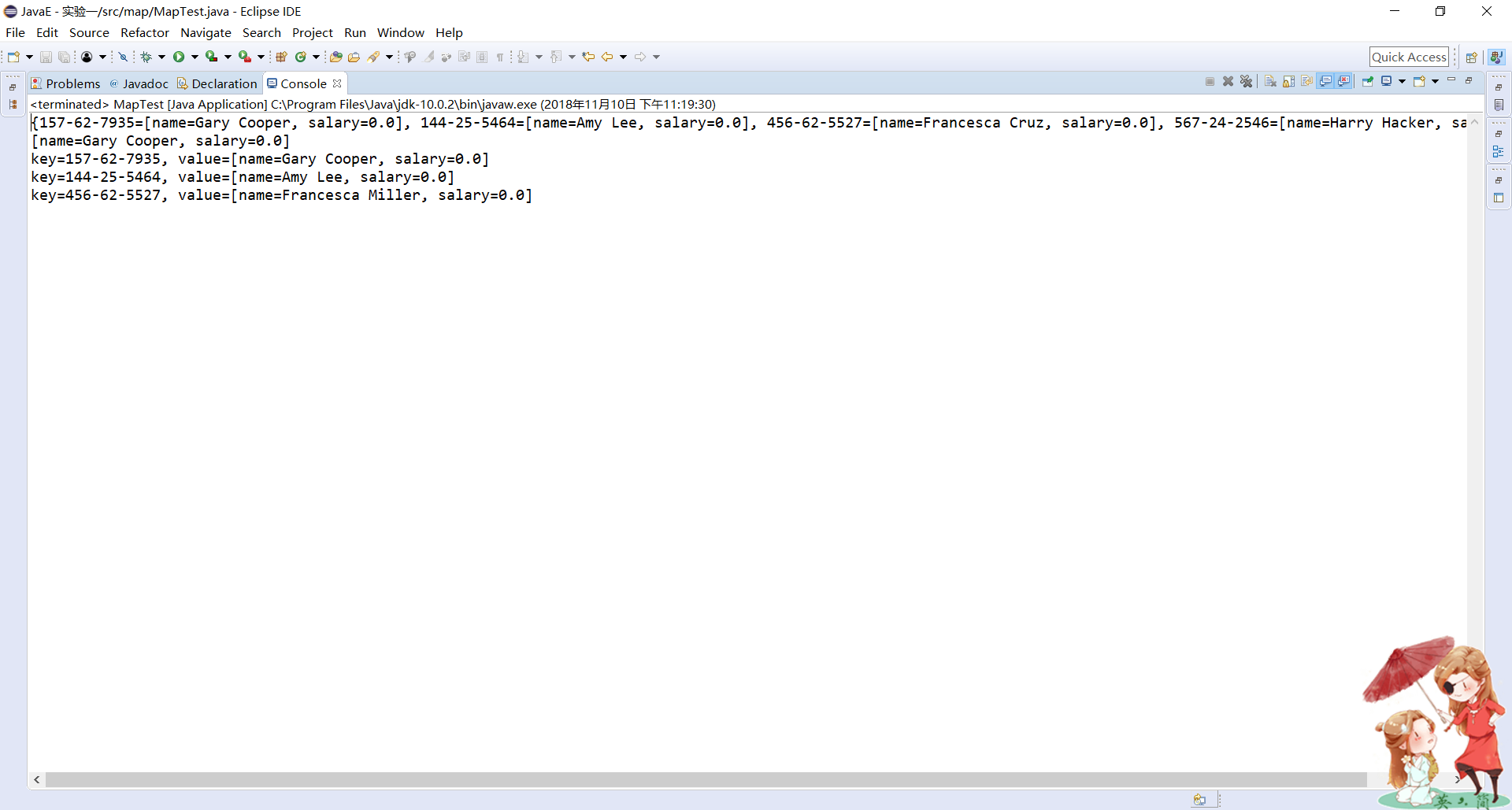
实验2:结对编程练习:
本次实验结对编程合作伙伴:冯志霞
实验九编程练习1:
package fzx;
import java.io.BufferedReader;
import java.io.File;
import java.io.FileInputStream;
import java.io.FileNotFoundException;
import java.io.IOException;
import java.io.InputStreamReader;
import java.util.ArrayList;
import java.util.Arrays;
import java.util.Collections;
import java.util.Scanner;
public class A{
private static ArrayList<Test> studentlist;
public static void main(String[] args) {
studentlist = new ArrayList<>();
Scanner scanner = new Scanner(System.in);
File file = new File("D:\身份证号.txt");
try {
FileInputStream fis = new FileInputStream(file);
BufferedReader in = new BufferedReader(new InputStreamReader(fis));
String temp = null;
while ((temp = in.readLine()) != null) {
Scanner linescanner = new Scanner(temp);
linescanner.useDelimiter(" ");
String name = linescanner.next();
String number = linescanner.next();
String sex = linescanner.next();
String age = linescanner.next();
String province =linescanner.nextLine();
Test student = new Test();
student.setName(name);
student.setnumber(number);
student.setsex(sex);
int a = Integer.parseInt(age);
student.setage(a);
student.setprovince(province);
studentlist.add(student);
}
} catch (FileNotFoundException e) {
System.out.println("学生信息文件找不到");
e.printStackTrace();
} catch (IOException e) {
System.out.println("学生信息文件读取错误");
e.printStackTrace();
}
boolean isTrue = true;
while (isTrue) {
System.out.println("1:字典排序");
System.out.println("2:输出年龄最大和年龄最小的人");
System.out.println("3:寻找老乡");
System.out.println("4:寻找年龄相近的人");
System.out.println("5:退出");
String m = scanner.next();
switch (m) {
case "1":
Collections.sort(studentlist);
System.out.println(studentlist.toString());
break;
case "2":
int max=0,min=100;
int j,k1 = 0,k2=0;
for(int i=1;i<studentlist.size();i++)
{
j=studentlist.get(i).getage();
if(j>max)
{
max=j;
k1=i;
}
if(j<min)
{
min=j;
k2=i;
}
}
System.out.println("年龄最大:"+studentlist.get(k1));
System.out.println("年龄最小:"+studentlist.get(k2));
break;
case "3":
System.out.println("province?");
String find = scanner.next();
String place=find.substring(0,3);
for (int i = 0; i <studentlist.size(); i++)
{
if(studentlist.get(i).getprovince().substring(1,4).equals(place))
System.out.println("province"+studentlist.get(i));
}
break;
case "4":
System.out.println("年龄:");
int yourage = scanner.nextInt();
int near=agematched(yourage);
int value=yourage-studentlist.get(near).getage();
System.out.println(""+studentlist.get(near));
break;
case "5":
isTrue = false;
System.out.println("退出程序!");
break;
default:
System.out.println("输入有误");
}
}
}
public static int agematched(int age) {
int j=0,min=53,value=0,k=0;
for (int i = 0; i < studentlist.size(); i++)
{
value=studentlist.get(i).getage()-age;
if(value<0) value=-value;
if (value<min)
{
min=value;
k=i;
}
}
return k;
}
}
package fzx;
public class Test implements Comparable<Test> {
private String name;
private String number ;
private String sex ;
private int age;
private String province;
public String getName() {
return name;
}
public void setName(String name) {
this.name = name;
}
public String getnumber() {
return number;
}
public void setnumber(String number) {
this.number = number;
}
public String getsex() {
return sex ;
}
public void setsex(String sex ) {
this.sex =sex ;
}
public int getage() {
return age;
}
public void setage(int age) {
this.age= age;
}
public String getprovince() {
return province;
}
public void setprovince(String province) {
this.province=province ;
}
public int compareTo(Test o) {
return this.name.compareTo(o.getName());
}
public String toString() {
return name+" "+sex+" "+age+" "+number+" "+province+"
";
}
}
运行结果:
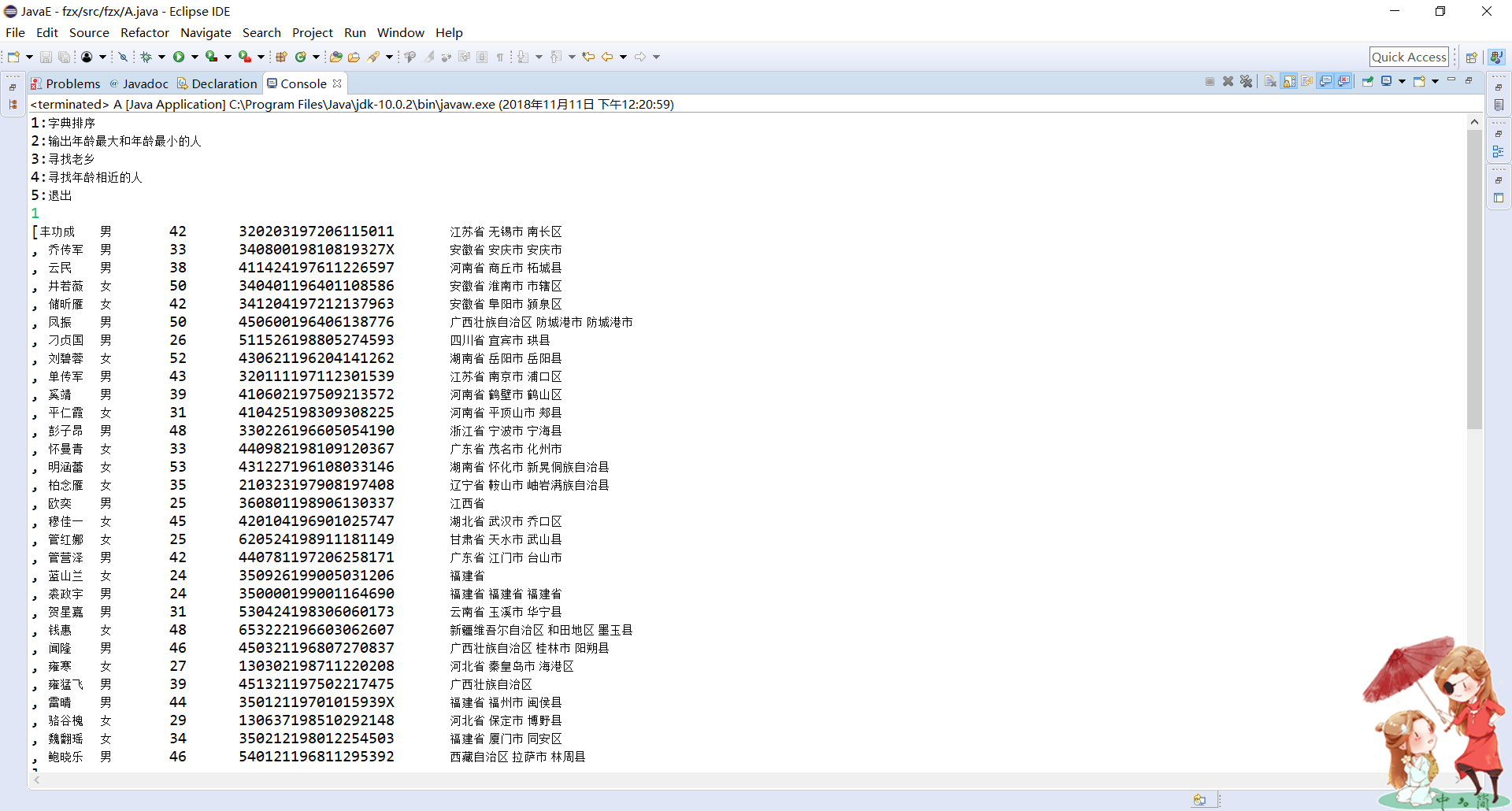
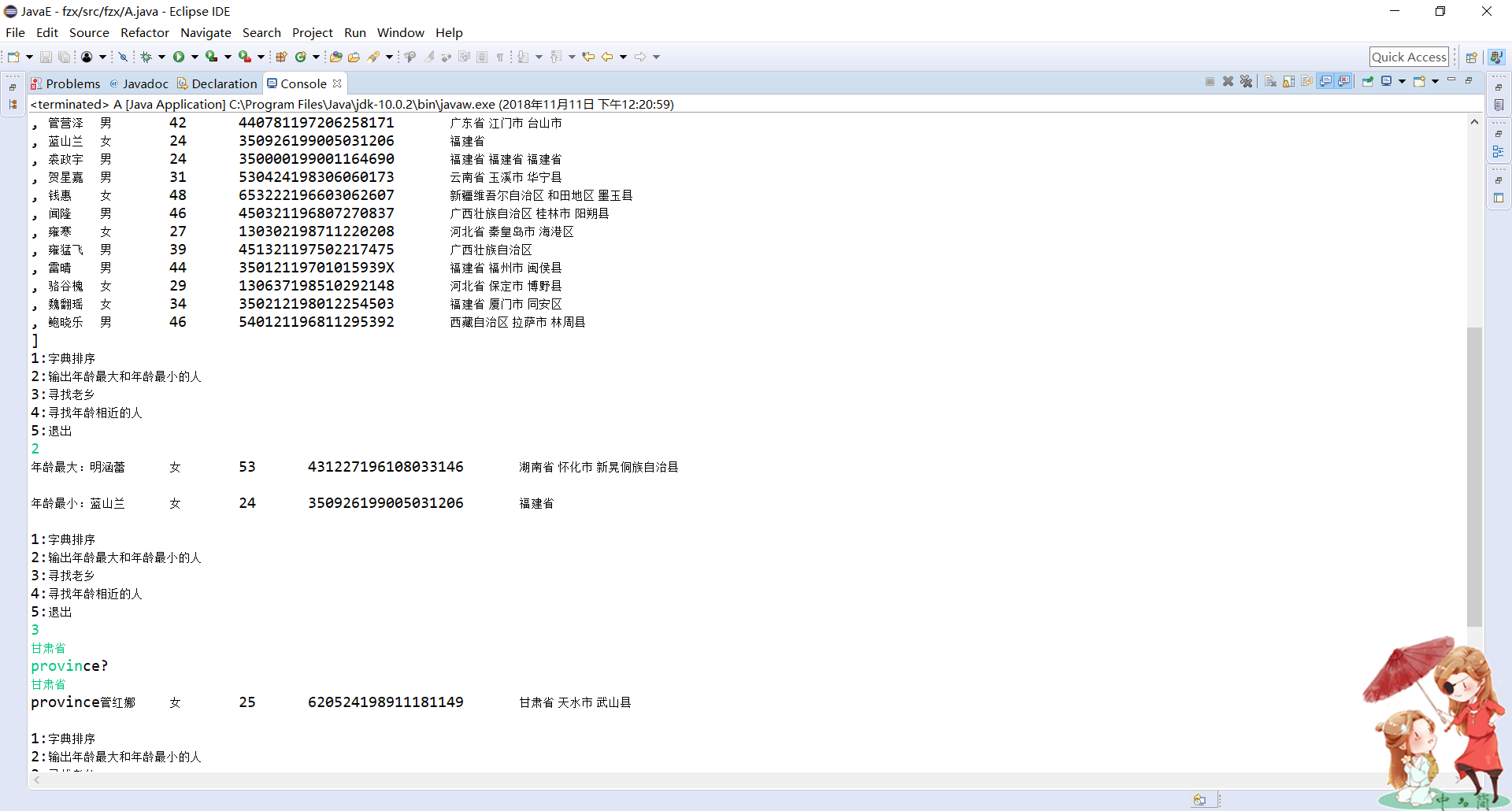
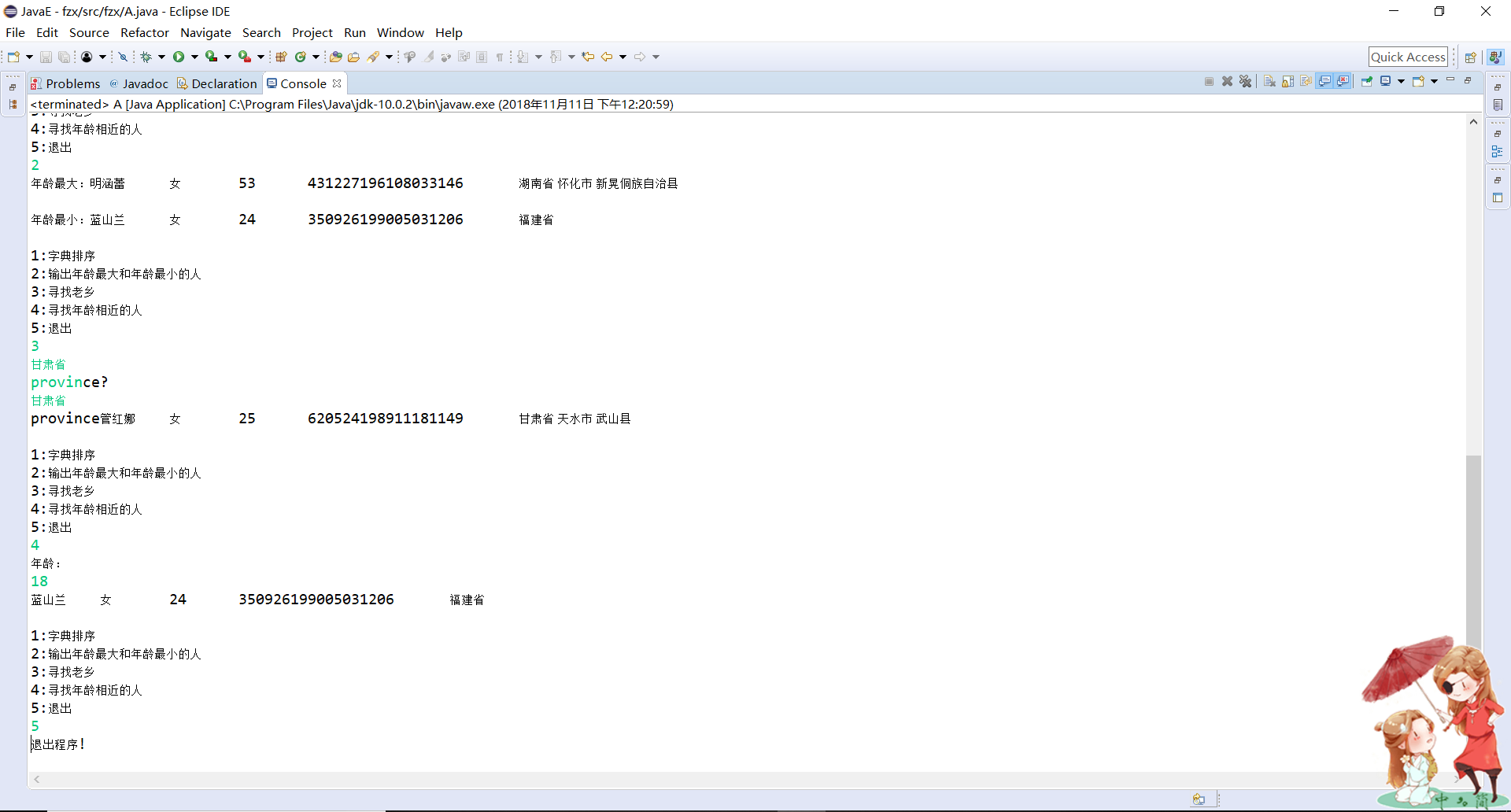
我认为这个程序在输出要求方面没有错误,如果代码能够更加规范,简洁就很好了
实验十编程练习2:
package 算术;
import java.util.Random;
import java.util.Scanner;
import java.io.FileNotFoundException;
import java.io.PrintWriter;
public class Main{
public static void main(String[] args)
{
yunsuan counter=new yunsuan();//与其它类建立联系
PrintWriter out=null;
try {
out=new PrintWriter("D:/text.txt");//将文件里的内容读入到D盘名叫text的文件中
}catch(FileNotFoundException e) {
System.out.println("文件找不到");
e.printStackTrace();
}
int sum=0;
for(int i=0;i<10;i++)
{
int a=new Random().nextInt(100);
int b=new Random().nextInt(100);
Scanner in=new Scanner(System.in);
//in.close();
switch((int)(Math.random()*4))
{
case 0:
System.out.println( ""+a+"+"+b+"=");
int c1 = in.nextInt();
out.println(a+"+"+b+"="+c1);
if (c1 == counter.plus(a, b)) {
sum += 10;
System.out.println("答案正确");
}
else {
System.out.println("答案错误");
}
break ;
case 1:
if(a<b)
{
int temp=a;
a=b;
b=temp;
}//为避免减数比被减数大的情况
System.out.println(""+a+"-"+b+"=");
/*while((a-b)<0)
{
b = (int) Math.round(Math.random() * 100);
}*/
int c2 = in.nextInt();
out.println(a+"-"+b+"="+c2);
if (c2 == counter.minus(a, b)) {
sum += 10;
System.out.println("答案正确");
}
else {
System.out.println("答案错误");
}
break ;
case 2:
System.out.println(""+a+"*"+b+"=");
int c = in.nextInt();
out.println(a+"*"+b+"="+c);
if (c == counter.multiply(a, b)) {
sum += 10;
System.out.println("答案正确");
}
else {
System.out.println("答案错误");
}
break;
case 3:
while(b==0)
{ b = (int) Math.round(Math.random() * 100);//满足分母不为0
}
while(a%b!=0)
{
a = (int) Math.round(Math.random() * 100);
b = (int) Math.round(Math.random() * 100);
}
System.out.println(""+a+"/"+b+"=");
int c0= in.nextInt();
out.println(a+"/"+b+"="+c0);
if (c0 == counter.divide(a, b)) {
sum += 10;
System.out.println("答案正确");
}
else {
System.out.println("答案错误");
}
break;
}
}
System.out.println("totlescore:"+sum);
out.println(sum);
out.close();
}
}
package 算术;
public class yunsuan <T>{
private T a;
private T b;
public void yunsaun()
{
a=null;
b=null;
}
public void yunsuan(T a,T b)
{
this.a=a;
this.b=b;
}
public int plus(int a,int b)
{
return a+b;
}
public int minus(int a,int b)
{
return a-b;
}
public int multiply(int a,int b)
{
return a*b;
}
public int divide(int a,int b)
{
if(b!=0 && a%b==0)
return a/b;
else
return 0;
}
}
运行结果:
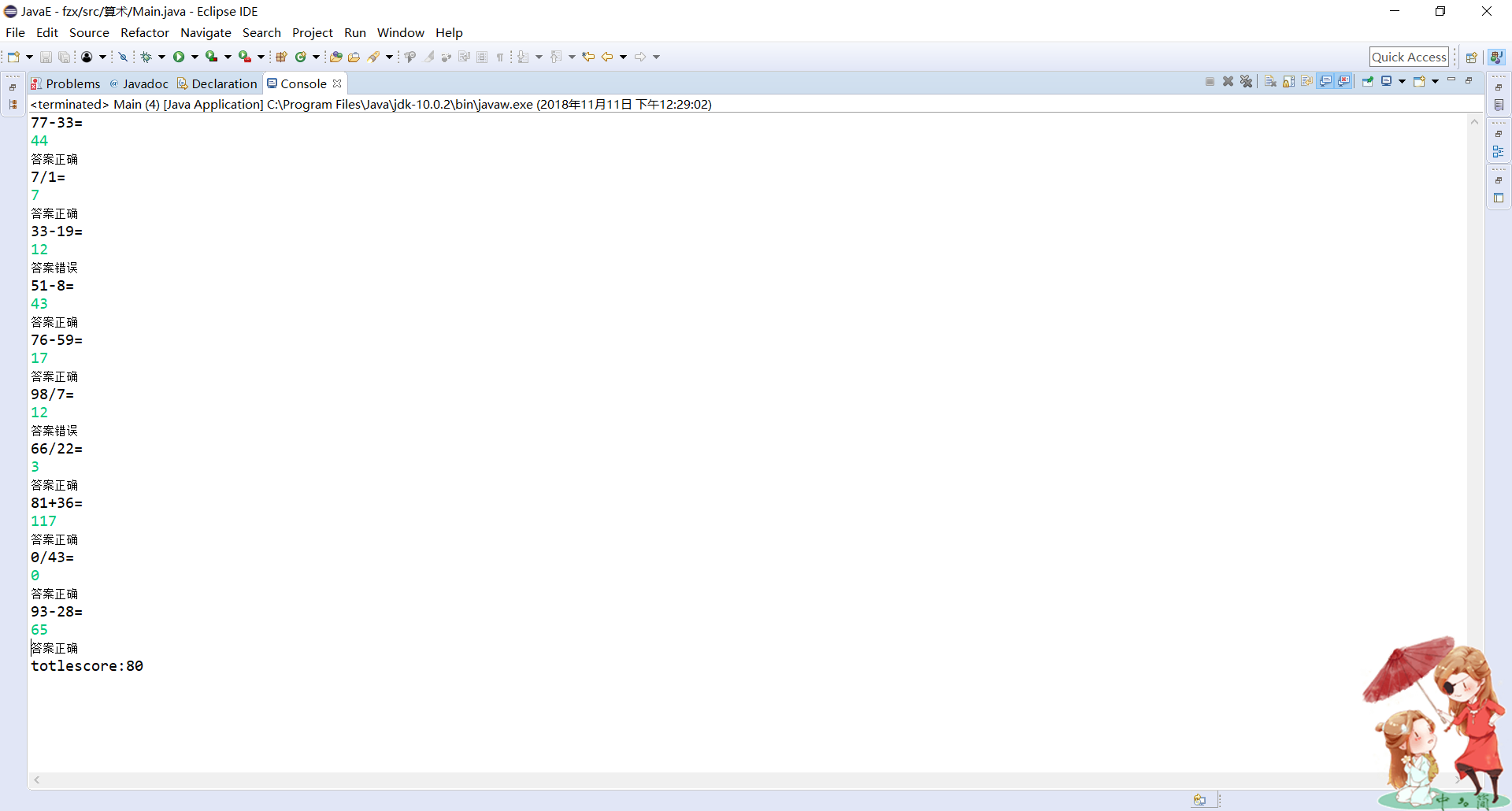
我认为这个程序在输出结果方面没有错误,相较于我的程序更加完善,在文件导出方面比我做的要好。
与学习伙伴合作完成实验九编程练习1
import java.io.BufferedReader;
import java.io.File;
import java.io.FileInputStream;
import java.io.FileNotFoundException;
import java.io.IOException;
import java.io.InputStreamReader;
import java.util.ArrayList;
import java.util.Arrays;
import java.util.Collections;
import java.util.Scanner;
public class A{
private static ArrayList<Test> studentlist;
public static void main(String[] args) {
studentlist = new ArrayList<>();
Scanner scanner = new Scanner(System.in);
File file = new File("D:\身份证号.txt");
try {
FileInputStream fis = new FileInputStream(file);
BufferedReader in = new BufferedReader(new InputStreamReader(fis));
String temp = null;
while ((temp = in.readLine()) != null) {
Scanner linescanner = new Scanner(temp);
linescanner.useDelimiter(" ");
String name = linescanner.next();
String number = linescanner.next();
String sex = linescanner.next();
String age = linescanner.next();
String province =linescanner.nextLine();
Test student = new Test();
student.setName(name);
student.setnumber(number);
student.setsex(sex);
int a = Integer.parseInt(age);
student.setage(a);
student.setprovince(province);
studentlist.add(student);
}
} catch (FileNotFoundException e) {
System.out.println("学生信息文件找不到");
e.printStackTrace();
} catch (IOException e) {
System.out.println("学生信息文件读取错误");
e.printStackTrace();
}
boolean isTrue = true;
while (isTrue) {
System.out.println("1:字典排序");
System.out.println("2:输出年龄最大和年龄最小的人");
System.out.println("3:寻找老乡");
System.out.println("4:寻找年龄相近的人");
System.out.println("5:退出");
String m = scanner.next();
switch (m) {
case "1":
Collections.sort(studentlist);
System.out.println(studentlist.toString());
break;
case "2":
int max=0,min=100;
int j,k1 = 0,k2=0;
for(int i=1;i<studentlist.size();i++)
{
j=studentlist.get(i).getage();
if(j>max)
{
max=j;
k1=i;
}
if(j<min)
{
min=j;
k2=i;
}
}
System.out.println("年龄最大:"+studentlist.get(k1));
System.out.println("年龄最小:"+studentlist.get(k2));
break;
case "3":
System.out.println("province?");
String find = scanner.next();
String place=find.substring(0,3);
for (int i = 0; i <studentlist.size(); i++)
{
if(studentlist.get(i).getprovince().substring(1,4).equals(place))
System.out.println("province"+studentlist.get(i));
}
break;
case "4":
System.out.println("年龄:");
int yourage = scanner.nextInt();
int near=agematched(yourage);
int value=yourage-studentlist.get(near).getage();
System.out.println(""+studentlist.get(near));
break;
case "5":
isTrue = false;
System.out.println("退出程序!");
break;
default:
System.out.println("输入有误");
}
}
}
public static int agematched(int age) {
int j=0,min=53,value=0,k=0;
for (int i = 0; i < studentlist.size(); i++)
{
value=studentlist.get(i).getage()-age;
if(value<0) value=-value;
if (value<min)
{
min=value;
k=i;
}
}
return k;
}
}
public class Test implements Comparable<Test> {
private String name;
private String number ;
private String sex ;
private int age;
private String province;
public String getName() {
return name;
}
public void setName(String name) {
this.name = name;
}
public String getnumber() {
return number;
}
public void setnumber(String number) {
this.number = number;
}
public String getsex() {
return sex ;
}
public void setsex(String sex ) {
this.sex =sex ;
}
public int getage() {
return age;
}
public void setage(int age) {
this.age= age;
}
public String getprovince() {
return province;
}
public void setprovince(String province) {
this.province=province ;
}
public int compareTo(Test o) {
return this.name.compareTo(o.getName());
}
public String toString() {
return name+" "+sex+" "+age+" "+number+" "+province+"
";
}
}
输出结果:
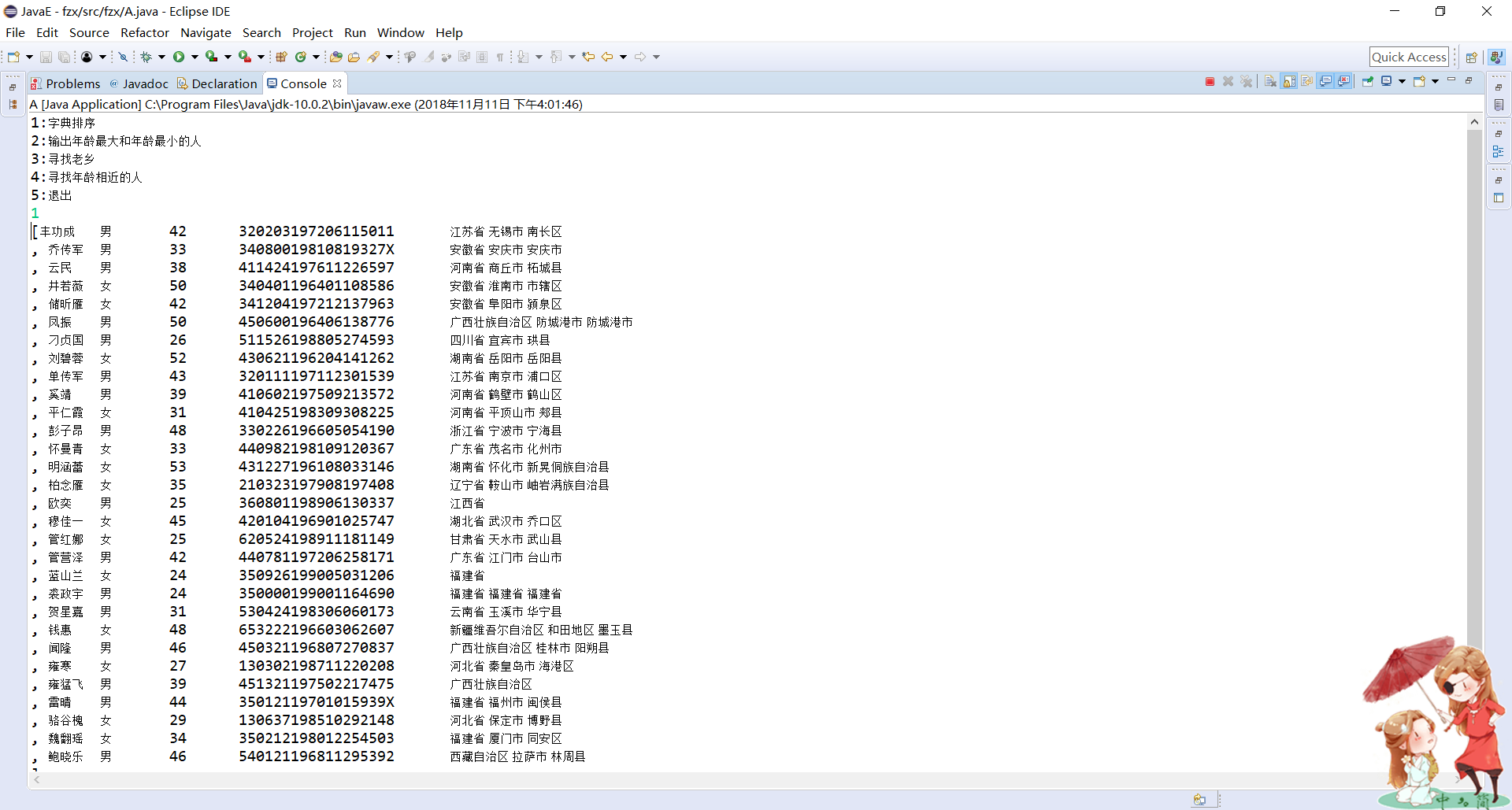
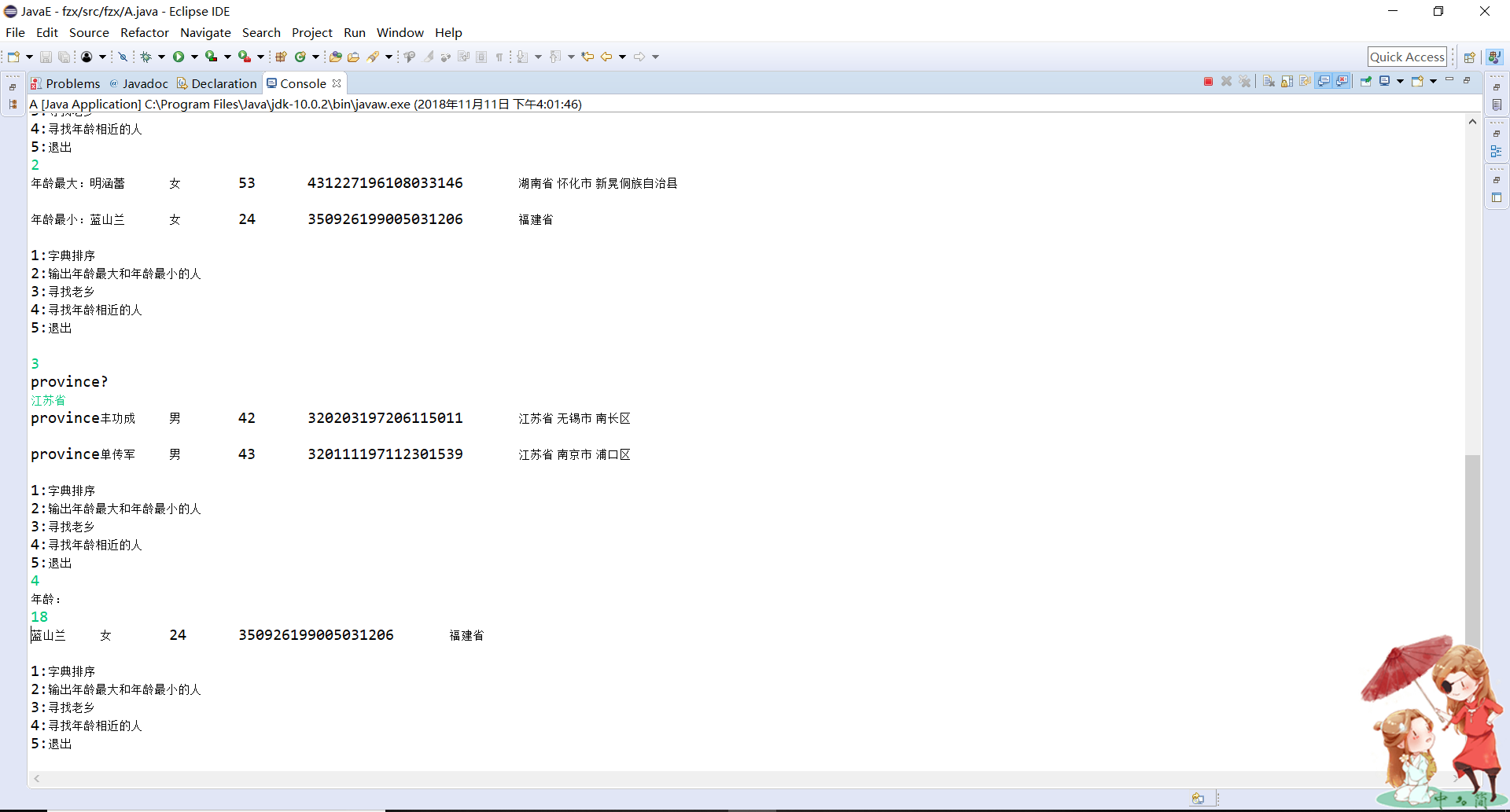
与学习伙伴合作完成实验十编程练习2:
package 算术;
import java.util.Random;
import java.util.Scanner;
import java.io.FileNotFoundException;
import java.io.PrintWriter;
public class Main{
public static void main(String[] args)
{
yunsuan counter=new yunsuan();//与其它类建立联系
PrintWriter out=null;
try {
out=new PrintWriter("D:/text.txt");//将文件里的内容读入到D盘名叫text的文件中
}catch(FileNotFoundException e) {
System.out.println("文件找不到");
e.printStackTrace();
}
int sum=0;
for(int i=0;i<10;i++)
{
int a=new Random().nextInt(100);
int b=new Random().nextInt(100);
Scanner in=new Scanner(System.in);
//in.close();
switch((int)(Math.random()*4))
{
case 0:
System.out.println( ""+a+"+"+b+"=");
int c1 = in.nextInt();
out.println(a+"+"+b+"="+c1);
if (c1 == counter.plus(a, b)) {
sum += 10;
System.out.println("答案正确");
}
else {
System.out.println("答案错误");
}
break ;
case 1:
if(a<b)
{
int temp=a;
a=b;
b=temp;
}//为避免减数比被减数大的情况
System.out.println(""+a+"-"+b+"=");
/*while((a-b)<0)
{
b = (int) Math.round(Math.random() * 100);
}*/
int c2 = in.nextInt();
out.println(a+"-"+b+"="+c2);
if (c2 == counter.minus(a, b)) {
sum += 10;
System.out.println("答案正确");
}
else {
System.out.println("答案错误");
}
break ;
case 2:
System.out.println(""+a+"*"+b+"=");
int c = in.nextInt();
out.println(a+"*"+b+"="+c);
if (c == counter.multiply(a, b)) {
sum += 10;
System.out.println("答案正确");
}
else {
System.out.println("答案错误");
}
break;
case 3:
while(b==0)
{ b = (int) Math.round(Math.random() * 100);//满足分母不为0
}
while(a%b!=0)
{
a = (int) Math.round(Math.random() * 100);
b = (int) Math.round(Math.random() * 100);
}
System.out.println(""+a+"/"+b+"=");
int c0= in.nextInt();
out.println(a+"/"+b+"="+c0);
if (c0 == counter.divide(a, b)) {
sum += 10;
System.out.println("答案正确");
}
else {
System.out.println("答案错误");
}
break;
}
}
System.out.println("你的总分为:"+sum);
out.println(sum);
out.close();
}
}
package 算术;
public class yunsuan <T>{
private T a;
private T b;
public void yunsaun()
{
a=null;
b=null;
}
public void yunsuan(T a,T b)
{
this.a=a;
this.b=b;
}
public int plus(int a,int b)
{
return a+b;
}
public int minus(int a,int b)
{
return a-b;
}
public int multiply(int a,int b)
{
return a*b;
}
public int divide(int a,int b)
{
if(b!=0 && a%b==0)
return a/b;
else
return 0;
}
}
输出结果:
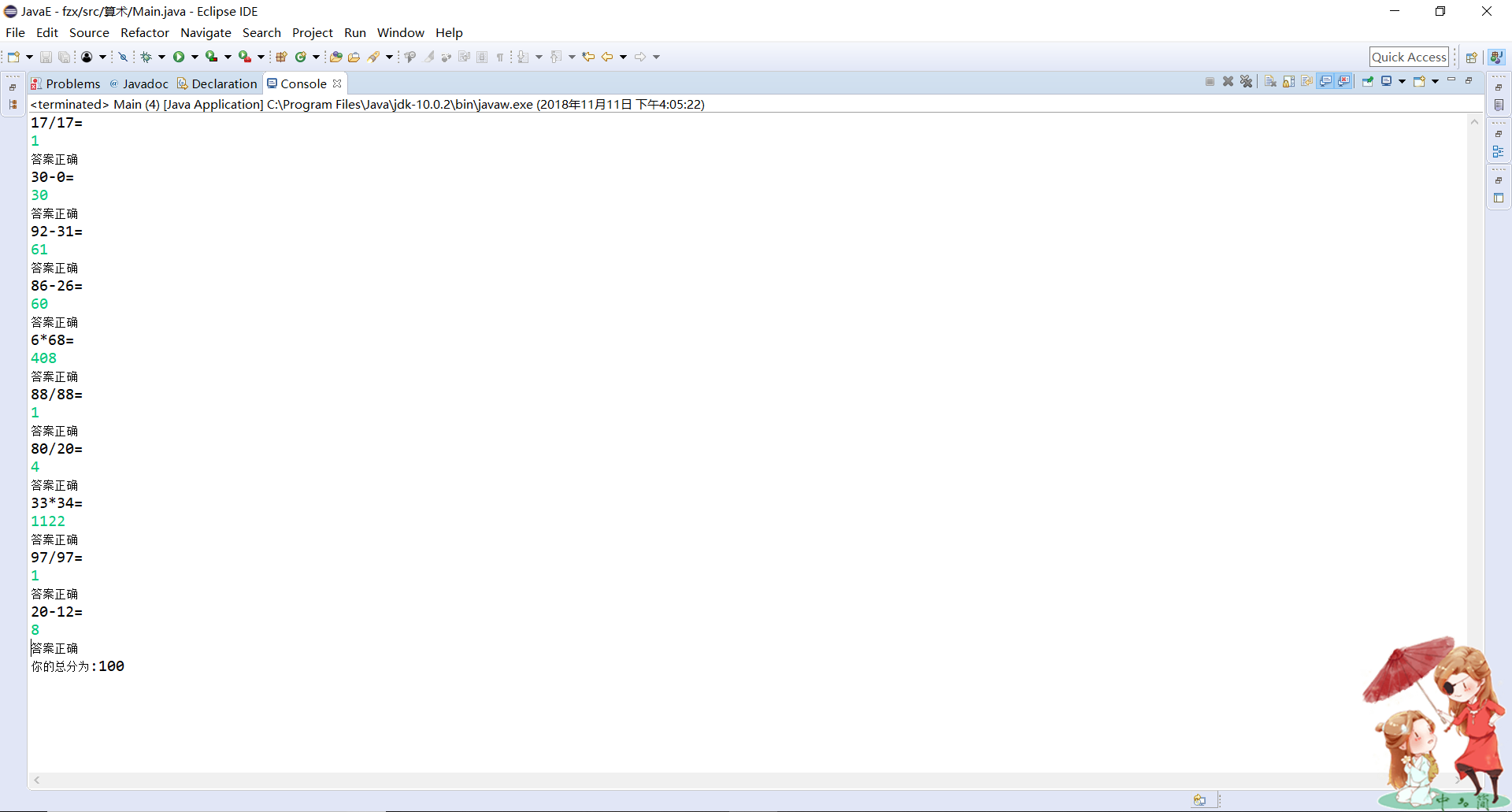
实验总结:
通过这周的学习,让我印象最深的是和同学组队进行编程的过程,通过参照学习伙伴的实验程序,我知道了我之前的程序的错误,比如在第二个编程实在计算题导出的地方我知道了自己的错误在哪,而且我的队友也很认真的给我讲解了我一直困惑的问题。和别人对比我才知道自己和别人的差距,比起之前的实验,有了更多和别人的交流,一起讨论,结合两个人的意见经验,对于代码有不同的看法,能对代码有不同的意见,是一次收获颇多的学习。